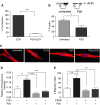Heat Shock-Related Protein 20 Peptide Decreases Human Airway Constriction Downstream of β2-Adrenergic Receptor
- PMID: 26909644
- PMCID: PMC4979360
- DOI: 10.1165/rcmb.2015-0139OC
Heat Shock-Related Protein 20 Peptide Decreases Human Airway Constriction Downstream of β2-Adrenergic Receptor
Abstract
Severe bronchospasm refractory to β-agonists is a challenging aspect of asthma therapy, and novel therapeutics are needed. β-agonist-induced airway smooth muscle (ASM) relaxation is associated with increases in the phosphorylation of the small heat shock-related protein (HSP) 20. We hypothesized that a transducible phosphopeptide mimetic of HSP20 (P20 peptide) causes relaxation of human ASM (HASM) by interacting with target(s) downstream of the β2-adrenergic receptor (β2AR) pathway. The effect of the P20 peptide on ASM contractility was determined in human and porcine ASM using a muscle bath. The effect of the P20 peptide on filamentous actin dynamics and migration was examined in intact porcine ASM and cultured primary HASM cells. The efficacy of the P20 peptide in vivo on airway hyperresponsiveness (AHR) was determined in an ovalbumin (OVA) sensitization and challenge murine model of allergic airway inflammation. P20 peptide caused dose-dependent relaxation of carbachol-precontracted ASM and blocked carbachol-induced contraction. The β2AR inhibitor, (±)-1-[2,3-(dihydro-7-methyl-1H-inden-4-yl)oxy]-3-[(1-methylethyl)amino]-2-butanol hydrochloride (ICI 118,551), abrogated isoproterenol but not P20 peptide-mediated relaxation. The P20 peptide decreased filamentous actin levels in intact ASM, disrupted stress fibers, and inhibited platelet-derived growth factor-induced migration of HASM cells. The P20 peptide treatment reduced methacholine-induced AHR in OVA mice without affecting the inflammatory response. These results suggest that the P20 peptide decreased airway constriction and disrupted stress fibers through regulation of the actin cytoskeleton downstream of β2AR. Thus, the P20 peptide may be a potential therapeutic for asthma refractory to β-agonists.
Keywords: airway smooth muscle relaxation; asthma; filamentous actin; ovalbumin mouse model; peptide therapeutic.
Figures





References
-
- Fanta CH. Asthma. N Engl J Med. 2009;360:1002–1014. - PubMed
-
- Sears MR, Taylor DR, Print CG, Lake DC, Li QQ, Flannery EM, Yates DM, Lucas MK, Herbison GP. Regular inhaled β-agonist treatment in bronchial asthma. Lancet. 1990;336:1391–1396. - PubMed
-
- Bakin AV, Rinehart C, Tomlinson AK, Arteaga CL. p38 mitogen-activated protein kinase is required for TGFβ-mediated fibroblastic transdifferentiation and cell migration. J Cell Sci. 2002;115:3193–3206. - PubMed
-
- Shore SA, Moore PE. Regulation of β-adrenergic responses in airway smooth muscle. Respir Physiol Neurobiol. 2003;137:179–195. - PubMed
Publication types
MeSH terms
Substances
Grants and funding
LinkOut - more resources
Full Text Sources
Other Literature Sources

